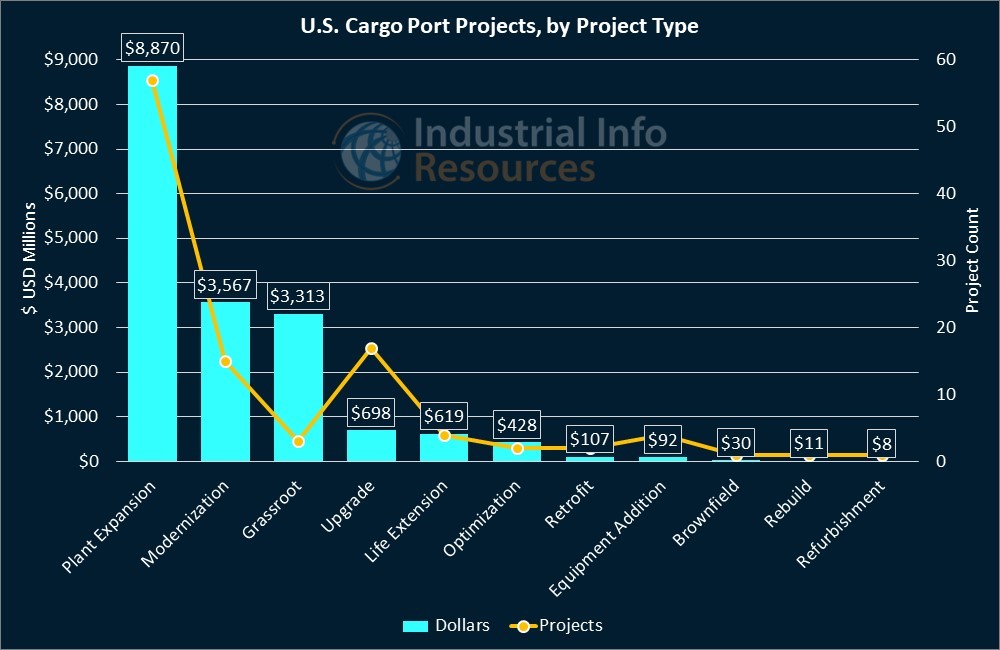U.S. Home to $17 Billion in Cargo Port Projects
Amid rising container activity at cargo ports across the country, Industrial Info is tracking about $17 billion worth of active and planned projects at U.S. cargo ports, 50% of which is attributed to expansion projects.
February container activity at the ports of Los Angeles and Long Beach, which handle about 40% of all cargo containers entering the U.S., jumped 60% and 24.1% year-over-year, respectively.
"With American consumers still spending and economic indicators positive, the Port of Los Angeles is well-positioned as we move into the second quarter," said Gene Seroka, executive director of the Port of Los Angeles, at a March 18 media briefing.
In a March 13 press release, the Port of Long Beach said "cooling inflation, rising consumer confidence and an ongoing effort to recapture market share" boosted the port's volume of handled cargo in February. The Port of Los Angeles processed 781,434 twenty-foot equivalent units (TEUs) that month, while the Port of Long Beach handled 674,723 TEUs.
The latter port's major effort is its new Pier B On-Dock Rail Support Facility, which will be completed in segments. It is designed to double the size of the existing Pier B rail yard and more than triple the port's annual on-dock rail cargo handling capacity, from 1.5 million TEUs to 4.7 million. The port said in November it planned to solicit bids for the first segment of construction during the first quarter and start construction in the fall.
In the November press release, the port said constructing the facility involves adding more than 130,000 feet of rail, quadrupling the number of tracks from 12 to 48 and widening the rail bridge over the Dominguez Channel from two to three tracks, among other work. Subscribers to Industrial Info's Global Market Intelligence (GMI) Industrial Manufacturing Project Database can click here for the related project reports.
"We're eager to break ground and start laying new tracks for this transformative facility," said Long Beach Harbor Commission President Bobby Olvera Jr. "Expanding and modernizing this rail yard allows our port to move more cargo faster, more efficiently and more safely to markets across the nation."
Other ports also are seeing a boost in container activity. The Georgia Ports Authority's (GPA) Port of Savannah handled 14.4% more container units in February year-over-year (451,670 TEUs); this followed another month of growth in January. According to the GPA, the port is the closest and fastest port (by rail) to major cities such as Atlanta, Georgia; Birmingham, Alabama; Charlotte, North Carolina; Memphis, Tennessee; and Orlando, Florida.
Industrial Info is tracking projects aimed at expanding the port's capacity, including a $200 million Phase 2 expansion of the Garden City Terminal West, which is under construction and designed to add 1 million TEUs of annual rail capacity. Expected to wrap up around the end of the year, the project entails constructing a new container storage yard, an in/out gate complex and about one mile of roadway connecting the new yard and the terminal. Later this year, the port aims to begin a $250 million Phase 2 modernization of the port's Ocean Terminal, which entails transforming the terminal into an all-container operation, which will shift most of its breakbulk cargo to the Georgia Port Authority's Port of Brunswick. "Breakbulk" refers to cargo not in shipping containers, but smaller containers such as bags, boxes, crates, drums or barrels.
Subscribers can read more information on the Garden City and Ocean terminal projects.
Also underway are the U.S. Army Corps of Engineers' (USACE) efforts to construct a new lock at the Soo Locks shipping channel, located along St. Mary's River in Sault Saint Marie, Michigan. A ship lock works to raise ships to higher or lower elevations, and this particular system enables ships to travel between Lake Superior and the lower Great Lakes by allowing vessels to be raised or lowered 21 feet.
The site currently consists of four locks as well as two decommissioned locks. However, only the Poe Lock has the necessary dimensions to serve all of the vessels that pass through. "Nearly all (88%) domestically produced advanced high-strength steel used to manufacture products like automobiles and appliances is made with taconite (iron ore) restricted by vessel size to the Poe Lock," the USACE said in a press release last year. "The New Lock at the Soo project is constructing a second Poe-sized lock (110 feet by 1,200 feet) in the existing footprint of the decommissioned Sabin Lock.
The Phase 1 upgrade at Soo Locks, which deepened an approach channel in preparation for the new lock, wrapped up in 2022. The two subsequent phases already are underway: Phase 2 includes rehabilitating the upstream approach walls to stabilize the existing approach walls, allowing modern vessels to tie up and wait to pass through the new lock; the completion is expected this summer. Phase 3 involves demolishing an existing lock, constructing the new lock chamber walls and floor, installing mechanical and electrical systems and constructing a new pump well; the project is estimated to wrap up in summer 2030. Subscribers can see the project reports on Phase 2 and Phase 3.

Subscribers to Industrial Info's GMI Database can click here for a full list of active and planned projects at U.S. cargo ports.
Click here for a full list of detailed reports for projects mentioned in this article, and click here for a full list of related plant profiles.

